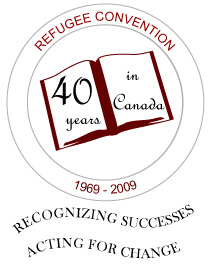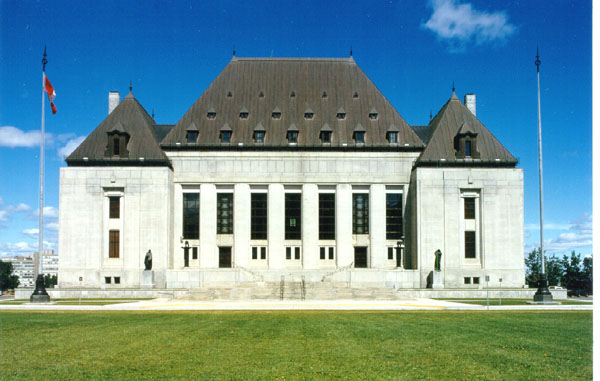|
|

On 4 June 1969, Canada signed the Convention relating to the Status of Refugees, 18 years after it was adopted by the United Nations.
Since Canada signed the Refugee Convention, it has gained the enviable reputation of being a world leader in protecting refugees. There are important successes to celebrate. There are also significant shortcomings that call for action.
 |
In signing the Refugee Convention, Canada recognized that it has obligations towards refugees. Protecting refugees is not simply a humanitarian gesture, but a legal requirement. Refugees have rights, as the Supreme Court of Canada confirmed in the landmark 1985 Singh decision, which found that the Canadian Charter of Rights and Freedoms guarantees refugee claimants’ basic rights. |
 |
Over the past 40 years, Canada – our government, institutions and citizens – have increasingly recognized that refugees are different from immigrants because refugees do not choose to immigrate: they are forced to flee their homes. Their distinct realities are recognized in law, as well as in settlement services developed specifically to respond to refugees. Since 2002 the Immigration and Refugee Protection Act includes refugees in the title of our immigration legislation. As survivors, refugees have also made their distinct contributions to Canada. |
 Source: UNHCR
Source: UNHCR |
Over the past 40 years, more than half a million refugees have been resettled to Canada, where they can find safety and a permanent home and contribute their talents. 200,000 of them have been resettled thanks to the direct support of Canadians through the Private Sponsorship of Refugees Program, which was launched 30 years ago in 1979. In 1986 the people of Canada were awarded the Nansen medal by the UN High Commissioner for Refugees, in “recognition of their major and sustained contribution to the cause of refugees”. |
 Source: IRB
Source: IRB |
40 years ago, Canada had no refugee determination system. Today our system is seen as a model around the world. Among its strengths are that decisions are made by an independent quasi-judicial tribunal, the Immigration and Refugee Board, which is this year celebrating its 20th anniversary. Since 2002, the definition of those needing protection has been broadened to cover those facing return to torture or a risk to life. |
 |
When Canada signed the Refugee Convention, the country had recently shifted away from selecting immigrants based on race. It was only in the 1970s that non-European refugees began to be welcomed to Canada. Since then, Canada has been at the forefront of efforts to ensure equal protection for all refugees. In 1993, Canada became the first country to issue gender guidelines for use in refugee determination, recognizing that women can be persecuted on the basis of their gender. Canada has also been a world leader in protecting refugees persecuted on the basis of their sexual orientation. |
|
The Convention Relating to the Status of Stateless Persons was drafted by the United Nations at the same time as the Convention Relating to the Status of Refugees. More than 50 years later, Canada has still not signed it, leaving stateless persons in Canada without a solution: in detention, or in permanent limbo. There are an estimated 15 million stateless people in the world. |
|
The fundamental flaw in Canada’s refugee determination system is that claimants do not have access to an appeal on the merits from a negative decision. The result is that errors go uncorrected, putting refugees at risk of forced return to persecution. The current law, as passed by Parliament in 2001, does in fact grant refugees an appeal, but the sections of the law giving them that right have not been implemented. All that is needed is for the government to implement those sections of the law.
|
|
An acute and longstanding problem affecting many refugees is that they must wait years to be reunited with immediate family members. Processing of applications is often intolerably slow, especially in some regions of the world, notably Africa. DNA tests are frequently demanded and are expensive and time-consuming. Some refugees face specific barriers, such as children who have no right to family reunification under the law, and families affected by the “excluded family member” rule (Regulation 117(9)(d)).
|
|
Source: International Refugee Committee |
Canada could easily do much more to respond to the millions of refugees around the world living without a durable solution, including refugees who have been waiting many years for a solution. Recent resettlement numbers are much lower than they have been in the past: since 2000, fewer than 11,000 refugees have on average been resettled to Canada each year, compared to an annual average of 18,000 in the 1980s and 1990s. Canada could make a meaningful contribution towards solving some of the world’s Protracted Refugee Situations by increasing annual resettlement to 25,000. |
|
Most refugees resettled to Canada arrive with a debt of up to $10,000 because the government expects them to pay for their transportation to Canada and medical exams. Since refugees of course can’t afford these expenses, Canada offers them a loan, on which interest is charged. As a result, refugee families start their new life in Canada not only with the challenges of adapting to a new country, learning a new language, catching up with missed schooling and recovering from trauma, but also with a large debt. The government could easily lift this burden from refugees by absorbing the costs of the transportation and overseas medical expenses for refugees.
|
|
|
